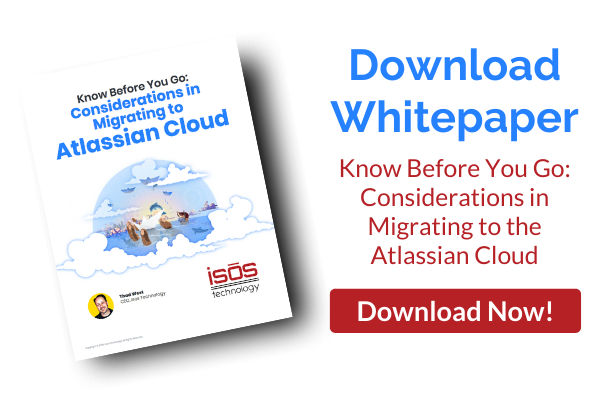
More than 90% of new Atlassian customers choose its Cloud deployment option. Among Cloud's many benefits, it allows customers to get started faster, increase productivity, streamline administration, and scale more efficiently. Further, as Atlassian phases out Server, the company is focused on enhancing its Cloud offerings, driving more existing customers than ever to make the shift from Server or Data Center to Cloud.
In the following FAQ, we answer common questions about migrating to Atlassian Cloud.
1. How do I know which Atlassian Cloud offering is right for my organization?
While more than 80% of Fortune 500 companies use Atlassian Cloud, it’s not just for businesses operating at scale—Atlassian has Cloud offerings for teams of all sizes, from less than ten to tens of thousands. They offer a free version for small teams, as well as Standard, Premium, and Enterprise tiers. The number of users, amount of storage, level of support, and uptime guarantee are all important in determining what tier is right for your organization. An Atlassian solution partner like Isos Technology can help you determine which Atlassian Cloud offering is the best fit.
Download our whitepaper: The Demystification of Atlassian Cloud: How to Choose the Right Plan for Your Organization
2. Are there cost benefits from migrating to Atlassian Cloud?
To better understand the financial impact of migrating to Atlassian Cloud, Atlassian commissioned Forrester Consulting to conduct an economic impact study. The study found that by deploying Jira Software and Confluence on Atlassian Cloud, a composite organization based on the characteristics of real Atlassian customers achieved a 155% ROI and $1.79M in savings with a payback period of only 6 months.
Read our blog post: The Total Economic Impact of Atlassian Cloud
3. Does Isos Technology have a process for cloud migration?
Isos Technology has an abundance of experience helping organizations of all sizes migrate to Atlassian Cloud. We have a process in place that is designed to ensure your new or merged Cloud instance supports your unique processes and will serve you well into the future. Our approach, which is designed to minimize downtime and risk, entails requirements development, solution architecture, system cleanup, active and historical data migration, user training, and post-implementation support.
Download our whitepaper: How to Migrate to Atlassian Cloud in 8 Steps
4. What about apps? I’ve heard migrating apps can be challenging.
Cloud versions of apps often differ from their Server and Data Center counterparts—their functionality will likely be different, but that doesn’t necessarily equate to better or worse. It’s important to keep in mind that native functionality of your Atlassian tools will also be different in Cloud, so you may not want or need the same set of apps. An Atlassian partner like Isos Technology can help you determine what functionality you need in your Cloud instance, then work with you and with the app vendors to find the right solution set and bring your critical data over.
Download our whitepaper: Migrating to Atlassian Cloud? Seven Key Decisions to Make about Apps
5. How do I prepare for a migration? Do I need to clean up my instance?
Over time, Atlassian instances tend to become cluttered with inactive users, unused or duplicate apps, and obsolete projects, schema, and workflows. This can make it inefficient for users and slow the system down. A migration is a good opportunity to clean up the system by deleting inactive users and apps, deleting or archiving unneeded data, and consolidating workflows and custom fields. There’s no point in bringing over all that clutter—it’s costly, it increases risk, and it slows the process down.
Download our whitepaper: Practical Recommendations for Cleaning Up Your Atlassian Instance
6. How different will my Cloud instance be? Will my team need training?
A migration is a great time to streamline processes so that they better serve your organization’s current and future needs. Things will likely work a bit differently in your new Cloud instance—native functionality may be different, your app set might have changed or been consolidated, and even some of your workflows may have changed. Any new users will need to be onboarded, and existing users will need to know where to go to access the instance and how any changes impact their daily work.
Communicating changes about the instance and training users so they are set up to work efficiently as soon as the final cutover is made should be a part of your migration plan. Your Atlassian migration partner will have experience with this and can help with these activities.
7. I need to merge multiple instances. Are there any special considerations to keep in mind?
Merge migrations - migrations that entail merging one or more existing Atlassian Server, Data Center, or Cloud source instances, into a new or existing target Cloud instance - are increasingly common. As mergers and acquisitions bring together disparate ITSM and engineering teams, the new, combined organization often combines instances to improve governance, better manage dependencies, and gain efficiencies and economies of scale.
A straightforward migration of a single instance can be complex, but when combined with merging multiple instances, the complexity is even more substantial. Since each individual instance is tailored to meet the needs of the team or teams using it, the migration involves auditing and aligning many distinct user groups, determining what data is important to bring over to the target instance, developing and implementing overarching governance, as well as the technical challenges of reconciling these differences.
Despite the incredible benefits to be gained, it’s enough to cause even the most forward-thinking organizations to delay the transition. Still, with careful planning and the help of an experienced Atlassian partner, the process can be streamlined, the risk can be minimized, and your organization can begin reaping the benefits that come from overarching governance of Atlassian tools as well as from Cloud deployment.
Download our whitepaper: The Essential Guide to Merging Instances when Migrating to Atlassian Cloud
8. Do I need an Atlassian Partner to help with the migration? Can my in-house team handle it?
Migrating to Atlassian Cloud is a complex undertaking. While your in-house team is likely highly skilled in the day-to-day of managing your Atlassian instance, they may not have the specialized expertise necessary to architect and undertake a migration. Bandwidth can also be an issue—they are likely already quite busy managing their other responsibilities, and managing the migration may not be the best use of their time.
An experienced Atlassian partner can help an organization visualize a desirable and realistic end state, engage stakeholders, develop a roadmap, understand what is achievable within a given time frame, and implement the solution, all while minimizing risk and sidestepping potential pitfalls. An Atlassian migration partner also has deep knowledge of specialized Atlassian migration tools, and may even have developed proprietary tooling for challenging situations.
A migration is not the time to go it alone—there are real risks to your business if data is lost, there are problems with the final cutover and your systems are down, if your team isn’t prepared to work in the new system, or if the new instance doesn’t meet your needs. Conversely, there’s much to be gained when the migration goes well.
Download our whitepaper: Know Before You Go: Considerations when Migrating to Atlassian Cloud
Sign up to receive more great content
Learn more about Atlassian and how Isos can help by signing up to receive our latest blogs, eBooks, whitepapers and more.














